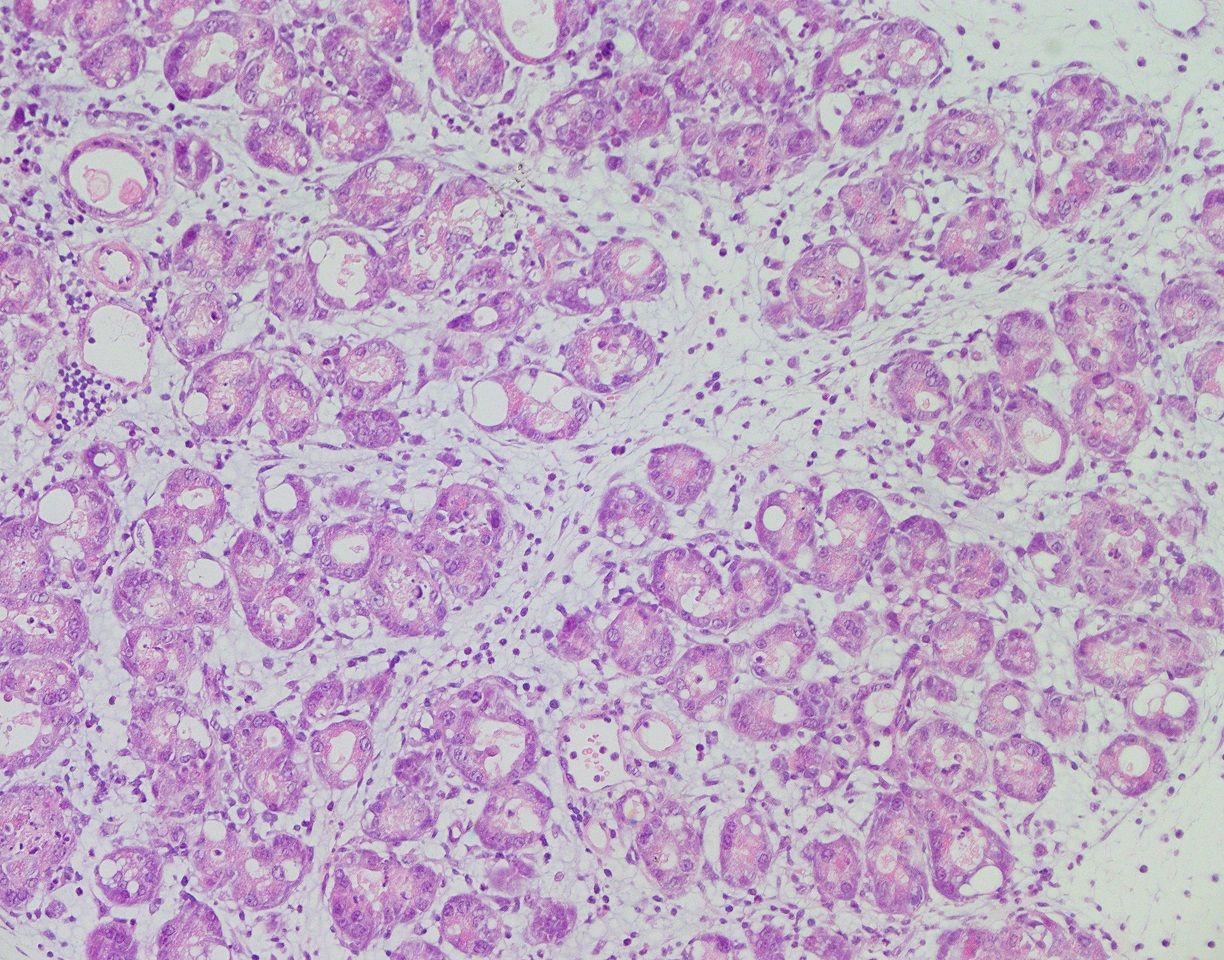Isidoro Cobo
Grupo de Carcinogénsis Epitelial, Centro Nacional de Investigaciones Oncológicas (CNIO), Madrid

[tabby title=»Español»]
La inflamación crónica es un factor de riesgo para el desarrollo de muchos tipos de tumores (Karin, M. & Clevers, H. 2010; Grivennikov, SI. et al. 2010; Crusz SM & Balkwill FR. 2015). La inflamación actúa como una espada de doble filo. Por un lado, es un mecanismo que permite al tejido responder frente a un insulto externo. Sin embargo, una inflamación pobremente regulada y/o persistente, puede favorecer el desarrollo de tumores.
NR5A2 es un gen cuyas variaciones polimórficas (SNP) están asociadas a un mayor riesgo de padecer cáncer de páncreas (Petersen GM et al, 2010; Amundadottir LT, 2016) y es necesario para la formación del páncreas y la función del mismo (Stein S & Schoonjans K, 2015; Mamrosh JL et al, 2014; Holmstrom SR et al, 2011; Molero X et al, 2012; Hale MA et al, 2014). En nuestro trabajo hemos demostrado que NR5A2 no solamente participa en la función normal del páncreas, sino que reprime un programa inflamatorio basal. De esta manera, la expresión reducida de NR5A2, tanto en ratones como en humanos, lleva a un estado pre-inflamatorio basal que se asemeja al escenario de los primeros estadíos de la pancreatitis.
En este estado pre-inflamatorio basal, NR5A2 sufre una translocación genómica, de los promotores de genes de diferenciación pancreática acinar, a los de los genes inflamatorios, en un proceso que depende de la sobre-expresión de las proteínas de la familia AP-1.
Estas investigaciones abren la posibilidad de identificar escenarios de predisposición a la inflamación, incluso cuando la histología y funcionalidad del órgano parece aparentemente normal.
Debido a la baja accesibilidad del páncreas, nuestra idea es intentar identificar marcadores del estado pre-inflamatorio en plasma, tanto de ratones como de humanos. Por otra parte, estamos intentando explorar la posibilidad de aumentar la función de la proteína NR5A2 in vitro e in vivo a través de nuevos fármacos que se unan a ella.
Me gustaría agradecer a todos los equipos de investigación que han contribuído a este trabajo. En particular, el grupo de Investigación de Erwin Wagner (Laboratorio de Genes, Desarrollo y Enfermedad, CNIO, Madrid), Núria Malats (Laboratorio de Epidemiología Molecular, CNIO, Madrid), Diego Megías (CNIO, Madrid), Laufey T. Amundadottir (Laboratorio de Genómica Translacional, Instituto Nacional del Cáncer, USA); Kristina Schoonjans (Escuela Politécnica Federal de Lausanne, Suiza).
[tabby title=»English»]
Chronic inflammation is a major risk factor for the development of several tumour types (Karin, M. & Clevers, H. 2010; Grivennikov, SI. et al. 2010; Crusz SM & Balkwill FR. 2015). Inflammation acts as a double-edged sword: on one hand, it is a precise mechanism that allows proper response upon damage. However, when de-regulated or persistent, inflammation can promote tumour development.
NR5A2 gene is indispensable for complete pancreatic acinar cell differentiation and homeostasis (Stein S & Schoonjans K, 2015; Mamrosh JL et al, 2014; Holmstrom SR et al, 2011; Molero X et al, 2012; Hale MA et al, 2014). SNPs in the vicinity of the NR5A2 locus have been associated with higher risk of developing pancreatic cancer (Petersen GM et al, 2010; Amundadottir LT, 2016).
In our work, we have demonstrated that, in addition to its role in pancreas homeostasis, NR5A2 restrains an inflammatory program in the pancreas. In this regards, reduced NR5A2 expression both in normal mouse and human pancreas, leads to a basal pre-inflammatory state that resembles that one observed in the early stages of pancreatitis.
During the pre-inflammatory state, NR5A2 is genomically relocated from the promoter of acinar differentiation genes to the promoter of inflammatory genes in a process that is dependent on AP-1 proteins.
Our work opens the possibility of identifying scenarios of pre-inflammation in other tissues even when histology and functionality seems normal.
Due to the low accessibility of pancreas tissue, we are currently exploring the possibility of identifying markers of the pre-inflammatory state in blood, both in mouse and human samples. We are also studying the pharmacologically manipulation of NR5A2 to enhance its transcriptional activity both in vitro and in vivo.
I would like to thank all groups that have been involved in this project. In particular, Erwin Wagner and Latifa Bakiri (Genes, Development and Disease group, CNIO, Madrid); Núria Malats (Laboratory of Molecular Epidemiology, CNIO, Madrid); Diego Megías (Confocal Microscopy Unit, CNIO, Madrid); Laufey T. Amundadottir (Translational Genomic Laboratory, National Cancer Institute, USA); and Kristina Schoonjans (École Polythechnique Laussane, Switzerland).
[tabbyending]
Referencia:
Cobo I, et al. Transcriptional regulation by NR5A2 links differentiation and inflammation in the pancreas. Nature. 2018 Feb 22;554(7693):533-537. doi: http://dx.doi.org/10.1038/nature25751
Bibliografía:
Amundadottir LT. Pancreatic Cancer Genetics. Int J Biol Sci. 2016 Jan 28;12(3):314-25. doi: 10.7150/ijbs.15001
Crusz SM & Balkwill FR. Inflammation and cancer: advances and new agents. Nat Rev Clin Oncol. 2015 Oct;12(10):584-96. doi: 10.1038/nrclinonc.2015.105
Grivennikov, SI. et al. Immunity, inflammation, and cancer. Cell. 2010 Mar 19;140(6):883-99. doi: 10.1016/j.cell.2010.01.025
Karin, M. & Clevers, H. Reparative inflammation takes charge of tissue regeneration. Nature. 2016 Jan 21;529(7586):307-15. doi: 10.1038/nature17039
Hale MA. et al. The nuclear hormone receptor family member NR5A2 controls aspects of multipotent progenitor cell formation and acinar differentiation during pancreatic organogenesis. Development. 2014 Aug;141(16):3123-33. doi: 10.1242/dev.109405
Holmstrom SR et al. LRH-1 and PTF1-L coregulate an exocrine pancreas-specific transcriptional network for digestive function. Genes Dev. 2011 Aug15;25(16):1674-9. doi: 10.1101/gad.16860911
Mamrosh JL. et al. Nuclear receptor LRH-1/NR5A2 is required and targetable for liver endoplasmic reticulum stress resolution. Elife. 2014 Apr 15;3:e01694. doi: 10.7554/eLife.01694
Moleto X. et al. Gene expression dynamics after murine pancreatitis unveils novel roles for Hnf1α in acinar cell homeostasis. Gut. 2012 Aug;61(8):1187-96. doi: 10.1136/gutjnl-2011-300360
Petersen GM. et al. A genome-wide association study identifies pancreatic cancer susceptibility loci on chromosomes 13q22.1, 1q32.1 and 5p15.33. Nat Genet. 2010 Mar;42(3):224-8. doi: 10.1038/ng.522
Stein S & Schoonjans K. Molecular basis for the regulation of the nuclear receptor LRH-1. Curr Opin Cell Biol. 2015 Apr;33:26-34. doi: 10.1016/j.ceb.2014.10.007
